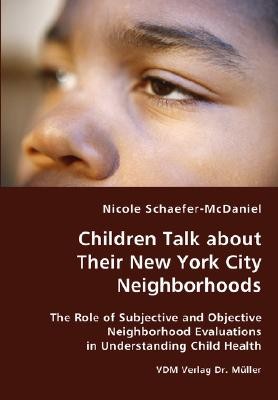
- We will send in 10–14 business days.
- Author: Nicole Schaefer-McDaniel
- Publisher: VDM Verlag Dr. Mueller E.K.
- Year: 2007
- Pages: 208
- ISBN-10: 3836427087
- ISBN-13: 9783836427081
- Format: 17 x 24.4 x 1.1 cm, softcover
- Language: English
- SAVE -10% with code: EXTRA
Children Talk about Their New York City Neighborhoods - The Role of Subjective and Objective Neighborhood Evaluations in Understanding Child Health (e-book) (used book) | bookbook.eu
Reviews
Description
What do New York City children have to say about their neighborhoods? Neighborhood research, the body of work exploring the link between the neighborhood context and residents' health, has received increasing attention in recent years. Despite the recent growth of neighborhood research, there has been surprisingly little attention to what children themselves say about the neighborhoods they live in. This study moves beyond traditional research by examining children's views of their inner-city New York City neighborhoods to inform on the neighborhood attributes most important to them. The research then explores the relationship between different neighborhood measurements (children's and parents' evaluations of neighborhood conditions, census data, and neighborhood observations by outside raters) and their association with children's health. The study answers questions such as "what is the relationship between subjective and objective neighborhood measures" and "whose ratings of neighborhood characteristics matter most to children's health." The book is directed towards scholars and researchers in urban health, urban planning, child development, and interdisciplinary studies.
EXTRA 10 % discount with code: EXTRA
The promotion ends in 21d.00:29:04
The discount code is valid when purchasing from 10 €. Discounts do not stack.
- Author: Nicole Schaefer-McDaniel
- Publisher: VDM Verlag Dr. Mueller E.K.
- Year: 2007
- Pages: 208
- ISBN-10: 3836427087
- ISBN-13: 9783836427081
- Format: 17 x 24.4 x 1.1 cm, softcover
- Language: English English
What do New York City children have to say about their neighborhoods? Neighborhood research, the body of work exploring the link between the neighborhood context and residents' health, has received increasing attention in recent years. Despite the recent growth of neighborhood research, there has been surprisingly little attention to what children themselves say about the neighborhoods they live in. This study moves beyond traditional research by examining children's views of their inner-city New York City neighborhoods to inform on the neighborhood attributes most important to them. The research then explores the relationship between different neighborhood measurements (children's and parents' evaluations of neighborhood conditions, census data, and neighborhood observations by outside raters) and their association with children's health. The study answers questions such as "what is the relationship between subjective and objective neighborhood measures" and "whose ratings of neighborhood characteristics matter most to children's health." The book is directed towards scholars and researchers in urban health, urban planning, child development, and interdisciplinary studies.


Reviews